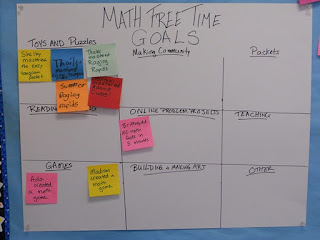* 1 student ponders over a math puzzle at her desk. She's been working on it for 30 minutes, but she promises that she's not frustrated yet
* 1 student is building a cube using K'Nex. The student next to him points out that his cube doesn't have square faces. Laughing, he takes apart his construction and starts again
* 4 small groups of students eagerly discuss angle measurements and fractions as they write the scripts for a math videos
* 1 student is working on a logic puzzle. Twenty minutes in, she gets frustrated and finds someone who's already done this puzzle to ask for strategy help. Fifteen minutes later a huge smile spreads across her face. She's finally finished it.
* 2 students lean over plastic tangrams, cheering with each completed puzzle
* 1 student sits at a computer happily answering place value questions
* 1 student sits at his desk with the Adams Cube, rearranging polygons to create new ones
 This year I've been doing something new - Math Free Time. In Math Free Time students have about 45 minutes to work toward the goal of their choice in mathematics. We've been doing free time for about 6 weeks and the students LOVE it! As with anything we do in the classroom, though, I noticed a few things that needed to be tweaked. So I introduced some changes to this week's free time.
This year I've been doing something new - Math Free Time. In Math Free Time students have about 45 minutes to work toward the goal of their choice in mathematics. We've been doing free time for about 6 weeks and the students LOVE it! As with anything we do in the classroom, though, I noticed a few things that needed to be tweaked. So I introduced some changes to this week's free time.This post will focus on the changes I've made to make math free time better. If you're interested in reading about how math free time works and our first few weeks, check out my original post: Free Choice in Math - Rigorously Engaging.
* The most important change I made was to reorganize goal-making. In math free time each student sets 3 goals to work toward. For our *new* math free time I set the options up as a bingo board, requiring the students to create a goal from each category to form a row of 3:
* The next change I made was to set a goal time limit. Previously I found that some students were working on the same goal time after time. Some students spent 6 entire weeks on one goal! They weren't slacking off, they just loved the activity and didn't want to switch.
Of course, I want them engaged in activities they enjoy, but I also want my students to try new things and to be proud of their accomplishments. Therefore, I set a time limit of 3 free time sessions to complete any goal.
* The final change is designed to help students be proud of their accomplishments. Rather than post their goals on bubbl.us (a GREAT free bubble map site), I created a goals poster where the students can post their accomplishments for all to see. Now their achievements are public. Just having these accomplishments published encourages both pride and motivation.
These three changes made one of our favorite activities even more wonderful. They've already doubled their goal-achieving ability! Another reason why reflection=change=good times.
~ Amanda
Pin It

AWESOME post, Amanda! I looove your descriptions of what these kids are doing. I am seeing the same thing in my own class and our free-choice time, and I've been thinking about tweaking our process as well. The bingo cards look great.
ReplyDeleteI'll write soon with more of what I'm up to. Thanks for sharing!!!